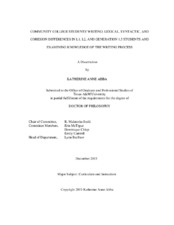| dc.description.abstract | Writing competently is a challenge for many college students. The need to improve writing at the postsecondary level has become a priority for business and education leaders alike in the United States. In the United States, for those who have not developed proficient English reading and writing skills, academic progress may be hampered on campuses where English is the primary language of instruction. Writing, especially for the diverse student population at the community college level, warrants attention in order to better guide instruction and assist students in achieving higher levels of proficient writing.
This study examined the writing of three groups of community college students: native English Language students (L1, n = 146), English as a Second Language students (L2, n = 33), and English as a Second Language students who graduated from high school in the United States and have lived in the United States for four or more years (Generation 1.5, n = 72). Writing samples and biographical survey information were gathered from students and samples were analyzed using the online tool, Coh-Metrix. The research questions used to guide this investigation examined the differences between these groups in terms of lexical, syntactic, and cohesion characteristics of proficient writing, as well as declarative and procedural knowledge of writing, and the impact of age of acquisition (AOA), parental education levels, and number of years of education in the United States on L2 and Generation 1.5 students’ writing.
Results indicated significant differences in syntactic and lexical measures between all groups, with effect sizes ranging from small to large. The majority of differences related to proficient writing were found between L1 and Generation 1.5. Responses regarding declarative knowledge, students focused mainly on clarity, audience, grammar, and spelling. Planning and revising were considered much less important. Responses regarding procedural knowledge focused on goal setting/planning, establishing purpose, writing, and revising, with less importance given to spelling and grammar. Finally, age of acquisition accounted for 10 % of the variation in students’ writing, specifically syntactic patterns, with parental education level and years of English studied in the United States having no significant impact. | en |


